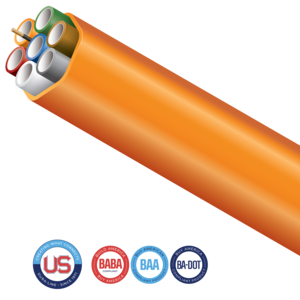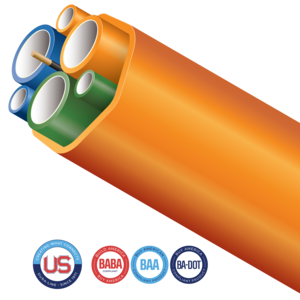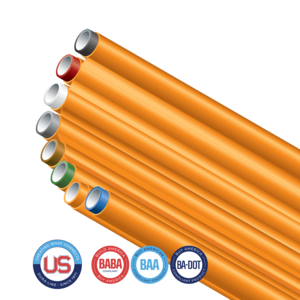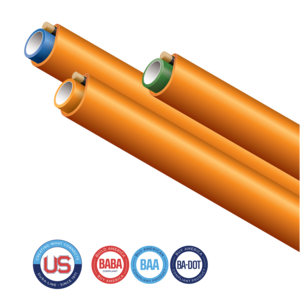CHALLENGE
As a WISP entering the fiber broadband market, Uplink, LLC wanted to serve their community and build their network as efficiently as possible in an area that the bigger telecom operators typically overlook: rural, remote, and disinvested for decades. Bureaucratic hurdles and a shrinking population meant that they would need to think outside the box for funding and get the right technology to make their Clarksdale, Mississippi build cost-effective, minimal-impact, and scalable.
SOLUTION
Uplink’s CEO Brian Smith and his team began researching conduit solutions, and discovered the multiple benefits of MicroTechnology. After working with Dura-Line’s sales staff, field application engineers, and expert industry partners, Brian chose single pathway MicroDucts that were locatable and FuturePath 2-way and 3-way 16/12mm from Dura-Line to protect their fiber optic cables. Unmatched support and service set Dura-Line apart from other infrastructure suppliers.
RESULTS
FuturePath from Dura-Line, as well as our extensive customer support and training throughout the transition to broadband, allowed Uplink to save money and build their network with additional capacity for the future.
Clarksdale, Mississippi, like much of rural America, has seen many of its residents and businesses leave over the decades to find opportunity and connectivity that most of the country now takes for granted. While others might struggle to find a commercial case in Clarksdale, Uplink -- a fledgling WISP -- knew they were in a position to bring much-needed broadband service to this rural farming community and grow their business at the same time.
“Clarksdale and the surrounding areas are a very rural agricultural community,” CEO Brian Smith notes. “There’s very low density here as far as population, so that makes it unique and a little bit difficult to serve, because it takes a lot of fiber to connect all these rural residents. But it’s also been a shrinking community -- there’s not a lot of industry here, and people are moving away to get connectivity. Even our farmers are moving an hour away to Oxford, Mississippi,to get that connectivity on their farms.”

Putting Public Funds to Work to Connect Rural America
Originally a wireless internet service provider (WISP), Smith realized during the COVID-19 pandemic that Uplink would need to expand to fiber broadband to support their existing customers and attract new ones. Although they were new to Fiber to the Home (FTTH), Uplink was confident they had a good shot at success with an innovative approach.
They decided to take advantage of federal grant programs to support their transition to FTTH. While the business case for this rural build might not have been clear to others, Brian and his team felt certain that the life-changing potential of connectivity would pay off in the long run for the entire community.
“To others, it doesn’t make a lot of economic sense, but to us, this is our backyard, these are our communities. We want to build out and serve them no matter what,” he says.
Brian applied for, and won, funds from several programs, primarily the USDA ReConnect Loan and Grant Program, which supports rural broadband expansion. Pursuing grants took time, but Brian affirms it paid off for Uplink.
“The grant processes have been very worthwhile. They’ve enabled Uplink to leverage those resources from the federal government to pursue fiber broadband in rural Mississippi, and that is definitely changing lives – broadband does change people’s lives.”
MicroTechnology Makes Dig-Once a Reality
With funds secure, Uplink then set out to find technical solutions that would allow them to accomplish two things: future-proof their build and minimize additional bureaucratic hurdles. When they began researching the products they’d need for their build, Brian and his team learned about MicroTechnology, and its potential for cost savings and minimal impact appealed to them.
“We started from zero knowledge. We were a wireless ISP, so when we started looking at fiber broadband, we started looking at MicroDuct and MicroCable, and the mass adoption wasn’t there in the US yet, and we couldn’t understand why. But it just made sense for us. We like that we have future capacity – if we need it, it's there,” Brian shares.
Becoming an early adopter of FuturePath turned out to be the best option for Uplink because it allowed them to minimize the amount of trenching and plan for scaling up. The additional pathways also provided greater flexibility in other network components, which saved Uplink time and money.
Like many ISPs expanding into unserved and underserved areas, Uplink also aims to be ready for BEAD’s stated dig-once priorities. FuturePath’s excess capacity means that when they decide to expand their network in the future, Uplink will be able to navigate challenges from state and local governments, such as environmental impact and cultural preservation requirements, with relative ease.
“Dura-Line FuturePath was key in Uplink's crossing of historically Native American lands. It allowed for minimal ground disturbance while having extra capacity to come back later without having to disturb the ground again,” Brian shares.
And as a small company new to broadband, Uplink found reassurance in Dura-Line’s exceptional customer support and training every step of the way.
“We chose Dura-Line because of the support as well as the product. There (are)a lot of products out there that are very similar. But in talking with the Dura-Line team, we found everyone was so eager in helping us understand the product as well as the use cases for it, and then supporting it by coming out and teaching us, once we got the product in hand, how to use it. It’s just been a great relationship with Dura-Line from the get-go,” Brian notes.
Bringing Life Back to Rural America, Made Easier with FuturePath
Uplink’s journey is proof-positive of the life-changing benefits of fiber broadband in rural communities. Brian shared that the access to fast, reliable, broadband internet that Uplink provides is already helping to bring life back to the Clarksdale area.
“I got a call from someone looking for broadband internet, and was planning to visit the area in a few weeks. I found out he was a NASA engineer that had grown up in this area, and he had inherited a house and wanted to move back, but his requirement was that he had great broadband internet – we provided that to him, and he was able to move back. It was an ‘aha!’ moment for me that showed me that we can actually repopulate rural America; we just need the infrastructure to support modern life.”
Now, with close to 2,000 homes passed in a community of 37 residents per square mile, Uplink is growing and planning expansion in the near future, utilizing BEAD funding as it becomes available to support their next 1,200-mile construction phase. Uplink’s success in this challenging market proves that if they can accomplish their goals where others won’t invest, the same is possible for other rural operators.









